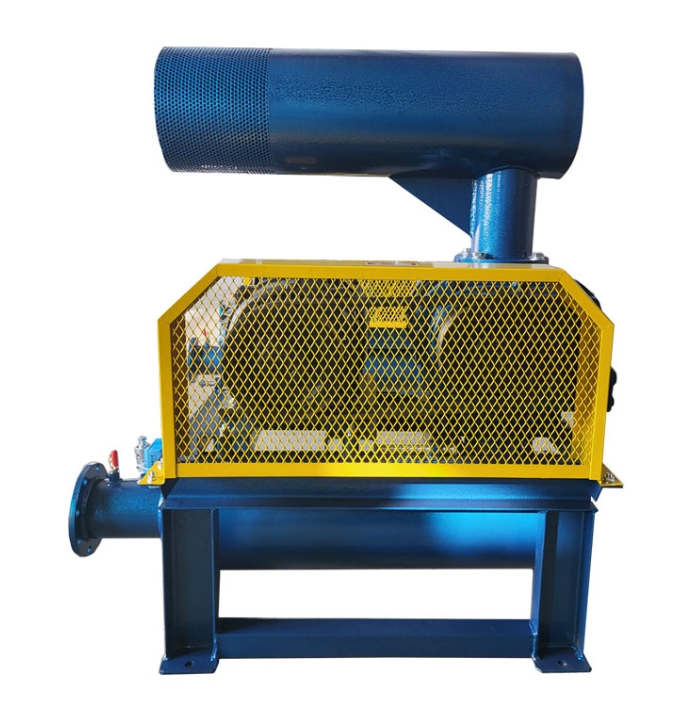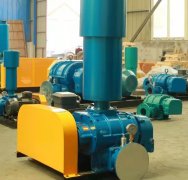Roots blower and centrifugal fan are two common gas conveying equipment in industry, with significant differences in their working principles, performance characteristics, and application scenarios. The following is a detailed comparative analysis:
---

**1、 Summary of Core Differences**
|* * Comparison item * * | * Roots blower * * | * * Centrifugal fan * *|
|------------------|-------------------------------|-----------------------------|
|* * Working principle * * | Volumetric (rotor engagement squeezing gas) | Kinetic (impeller rotation accelerating gas)|
|* * Pressure range * * | Medium and low pressure (9.8~98 kPa) | Low pressure (<10 kPa) or high pressure (>100 kPa)|
|* * Flow characteristics * * | Flow is constant and independent of pressure | Flow decreases with increasing pressure|
|Efficiency * * | 60~75 (lower) | 70~90 (higher)|
|* * Noise * * | Large (85-100 dB) | Small (70-85 dB)|
|* * Maintenance cost * * | Low (simple structure) | Medium high (requires dynamic balance correction)|
---
**2、 Differences in working principles**
**1. Roots blower**
-Principle of Volumetric Method:
By the reverse rotation of two parallel rotors, gas is "wrapped" from the inlet and pushed to the outlet, without internal compression, and pressure is established by system resistance.
**Features * *:
-Constant flow rate (proportional to rotational speed);
-The outlet pressure depends on the pipeline resistance (up to 0.1 MPa).
**2. Centrifugal fan**
-* * Kinetic energy principle * *:
The high-speed rotation of the impeller allows the gas to gain kinetic energy, which is then converted into static pressure energy after being expanded by the volute.
**Features * *:
-Flow rate is inversely proportional to pressure (flow rate decreases as system resistance increases);
-The pressure is determined by the impeller diameter and speed.
---
**3、 Performance comparison**
**1. Pressure flow curve**
-Roots blower:
! [Roots Curve]( https://example.com/roots_curve )
The flow rate hardly changes with pressure (constant flow characteristic).
-* * Centrifugal fan * *:
! [Centrifugal Curve]( https://example.com/centrifugal_curve )
The flow rate significantly decreases with the increase of pressure (margin should be reserved when selecting).
**2. Energy Efficiency Comparison**
-Roots blower: Low efficiency (especially at high pressure), but suitable for variable load conditions.
-Centrifugal fan: narrow zone, efficiency drops sharply when deviating from design conditions.
---
**4、 Application scenario selection**
**Prioritize Roots blower**
-Stable flow rate is required, such as aeration in sewage treatment and pneumatic conveying.
-Medium and low pressure requirements: pressure of 0.1~0.5 bar, flow rate of 1~200 m3/min.
-* * Dusty/humid gas * *: Strong structure and strong anti pollution ability.
**Prioritize centrifugal fans**
-High flow and low pressure: such as ventilation and air exchange (flow rate>300 m3/min, pressure<10 kPa).
-High pressure demand: Multi stage centrifugal fans can reach over 1.0 MPa.
-* * Clean gas * *: High requirements for the cleanliness of the medium.
---
**5、 Key parameters for selection**
|* * Parameters * * | * Roots blower * * | * * Centrifugal fan * *|
|------------------|-------------------------------|-----------------------------|
|* * Flow rate * * | Based on actual demand (constant) | Attenuation after pressure loss needs to be considered|
|* * Pressure * * | < 98 kPa (single-stage) | single-stage < 15 kPa, multi-stage > 100 kPa|
|* * Medium temperature * * | < 80 ℃ (standard type) | Up to 250 ℃ (special design)|
|Explosion proof requirements * * | Ex d Ⅱ BT4 (for chemical use) | Ex tD Ⅲ C (for dust explosion prevention)|
---
**6、 Maintenance and lifespan**
|* * Project * * | * Roots blower * * | * * Centrifugal fan * *|
|------------------|-------------------------------|-----------------------------|
|* * Daily maintenance * * | Regularly change oil, check gears/bearings | Clean impellers, calibrate dynamic balance|
|Common faults: rotor wear, seal leakage, impeller dust accumulation, and bearing overheating|
|* * Design lifespan * * | 8-10 years (rotor 50000 hours) | 10-15 years (impeller 100000 hours)|
---
**7、 Cost comparison**
-* * Procurement cost * *: Under the same parameters, Roots blowers are 20-30% more expensive than single-stage centrifugal blowers, but cheaper than multi-stage centrifugal blowers.
-* * Operating cost * *: Centrifugal fan section is more energy-efficient (Roots fan frequency conversion transformation can save 15% energy).
-* * Maintenance cost * *: Roots blowers have lower costs (spare parts are cheaper and easy to replace).
---
**8、 Typical Industry Applications**
**Roots blower**
-Sewage treatment aeration, carbon slurry plant aeration, vacuum packaging, aquaculture oxygenation.
**Centrifugal fan**
-Boiler induced draft, air conditioning system, dust removal equipment, tunnel ventilation.
---
**Summary**
-* * Choose Roots blower * *: Requires stable flow and resistance to fluctuations in operating conditions * * for medium and low pressure scenarios.
-* * Choose centrifugal fan * *: Pursuing clean gas delivery with high efficiency, large flow rate, or high pressure * *.
-* * Hybrid solution * *: Some scenarios can be used in parallel (such as Roots blower providing basic flow and centrifugal blower adjusting peak demand).
It is recommended to conduct a comprehensive evaluation based on the characteristics of the medium, pressure requirements, and operating costs, and if necessary, consult the fan manufacturer for performance matching testing.



